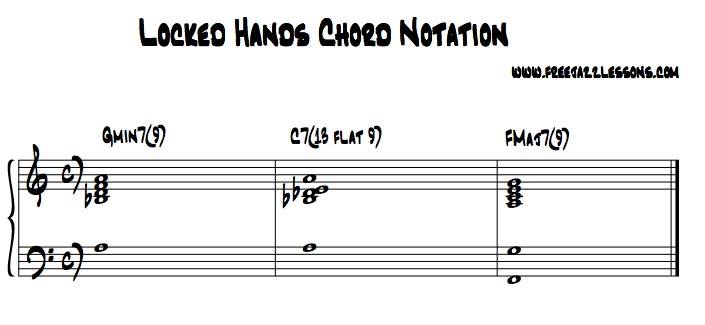Free Block Chord Piano Lesson
Do you want to learn more about block chords? Are you looking for an easy jazz piano lesson on the locked hand chord style? You’ve come to the right place!
In today’s lesson we’re going to take a look at a style of block chords made famous by George Shearing and Ahmad Jamal (video tutorial, notation, and tips below).
Block Chord Tutorial Guest Teacher
 So, a few nights ago I was at my friend Pete Benson’s gig at Andy’s Jazz Club in Chicago.
So, a few nights ago I was at my friend Pete Benson’s gig at Andy’s Jazz Club in Chicago.
Pete was playing all kinds of cool stuff that night but one thing I particularly liked was the way he would break into locked hand style every once in a while.
The whole time I was thinking, a) “Man, Pete sounds great playing this style!” and b) I should get Pete in to teach a lesson on block chords to the community here on FJL.
So, I convinced Pete to come in to the studio. He was kind enough to come in and film a couple short block chords tutorials.
Block Chord Video Tutorial
Why don’t you take 2 minutes and watch as Pete shows you how to play block chords inside a II-V-I chord progression. Then, scroll down for the notation and important extra tips.
5 Tips To Help You Learn Block Chord Basics
Here are some important tips that will help you master the basic concepts behind the locked hand chord style.
1. Double The Melody
The first step of getting these block chords under your hand is to double the melody an octave apart.
You do this by having the right hand play the melody on top of your voicing. Then, you have the left hand doubles the melody not an octave below.
2. Fill In The Chord Tones
Once you have the melody in octaves you simply fill in the rest of the chord tones in your right hand.
3. Every Note Is Harmonized
There are lots of different arrangement techniques you can use to harmonize jazz tunes. For example, here are a just a few types:
- Drop 2 voicings
- Red Garland voicings (which we discover in The Jazz Masters Method DVD and the Georgia on My Mind tutorial inside the Premium Membership Course)
- Quartal Voicings
- Spread Voicings (which we explore in depth inside the chords library of Premium Membership)
- So What Voicings
- Cluster voicings
- Rootless voicings
- Left hand walking bass + right hand melody and chord voicings (you can learn more about this inside the “There Is No Greater Love tutorial”
- Locked hand style voicings
- & many more
One of the things that’s distinctive to the locked hand style though is that every single melody note is harmonized with a new chord voicing.
It makes each melody note sound very rich and thick.
4. You Can Mix Locked Hand Chords In With Other Voicings
People like George Shearing would sometimes play a whole tune or a whole chorus of a solo just using block chords.
Then there are other artists who will mix in block chord voicings in with other chord techniques as well. Both methods are very cool but they of course create different sounds or textures.
Pete actually mixed his voicings up in the video above. He played the first 2 piano voicings in the locked hand style and then the 3rd one in more of an open style.
It creates a nice feeling of tension and release. So, I encourage you to mix and match these voicings into your playing.
5. Why We Study II-V-I Chord Progressions
The chord progression from this lesson is the II-V-I. It’s the most popular jazz chord progression and can literally be found in hundreds of tunes.
So, as long as you have a basic concept of how to transpose you can apply the chords from today’s lesson into tons of tunes.
Need a list of tunes to learn? Check out this lesson on essential jazz standards to learn and also this lesson to learn jazz standards.
Notation For These Chords
Please Welcome Pete!
Do you have a question about this lesson? Did you enjoy today’s lesson? Please leave a comment below and let us know.
I’d like to thank Pete Benson for taking time out of his busy schedule to come in and share music with us! Thanks Pete!
Also, since this is Pete’s first lesson on this site please make him feel welcome! Leave a comment below and welcome him to our community.
(By the way, Pete will also be showing you how to apply locked hand voicings inside an actual tune in a future tutorial. Make sure you watch for the lesson. It’s coming soon.)

